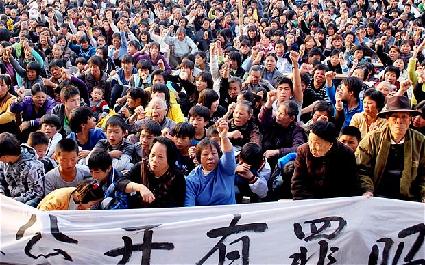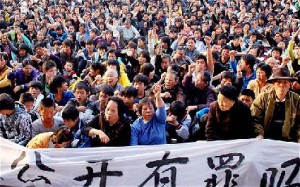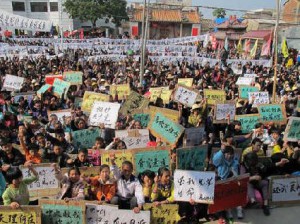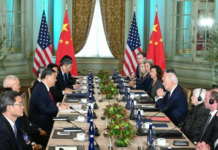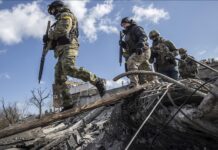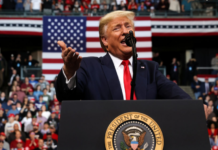Workers’ strikes and new local rebellions use the slogan “Learn from Wukan”
Vincent Kolo and Zhang Shujie, chinaworker.info
Wukan is the fishing village in southern China’s Guangdong province that achieved worldwide fame as a symbol of mass resistance. Like thousands of other rural communities in recent years, the 13,000 inhabitants of Wukan rose up against corrupt local officials who have stolen land and made millions in profits. But Wukan achieved something else, by displaying a new level of organisation and mass mobilisation, setting up independent popular committees and campaign structures. In so doing, Wukan has become a benchmark for future struggle in China.
Its people waged a daring and impressive four-month long struggle that ejected the local ‘communist’ (Chinese Communist Party) government, and set up their own elected council to run the community. Finally, in the face of repression, arrests, a siege by thousands of paramilitary police, and the death of a protest leader in police custody, a dramatic settlement was reached on 21 December that seemed to meet most of the villagers’ demands. At that time, chinaworker.info warned that the agreement with provincial CCP representatives could not be trusted; that continued mass pressure through the building of democratic grassroots organisations and links with other mass struggles was needed. Our warnings have been confirmed.
Still, the impact of the Wukan uprising is enormous and goes far beyond its boundaries and even those of Guangdong province. This was, according to numerous commentators, the first time since 1949 that the CCP totally lost control of an administrative area. During a few short weeks the struggle in Wukan shattered the idea that the Chinese people need one-party dictatorship and are incapable of governing themselves democratically.
At the time of writing, Wukan is conducting a three-stage election process to elect a new village government, and this process too is being watched closely by overseas media and – more importantly – by tens of thousands of Chinese netizens. The provincial CCP leaders, headed by the ambitious Wang Yang, a standard bearer for the party-state’s ‘economic liberal’ wing, intervened in December to broker a deal, resulting in the protest leaders agreeing to call off further action. This deal has spawned countless articles and speculation about a political shift and the advent of a new ‘Wukan approach’ to dealing with discontent. As our article will show, such hopes are misplaced.
Wukan incontestably marks an important new phase in the struggle of China’s rural masses, with repercussions also for the urban population – for the first time now a majority in China (51 percent) – and in particular for the working class, which is the most important force for change in society. For socialists and for the supporters of the CWI and chinaworker.info, there are many crucial lessons from the Wukan experience that must be discussed, understood and shared by all those seeking ways to fight against one-party dictatorship, its corruption and capitalist policies. As Lenin once said, an ounce of experience – in struggle – is worth a ton of theory.
Along with several other concurrent struggles – including some very significant workers’ strikes – Wukan shows that mass protests in China are becoming more organised, more bold, and their methods and tactics more sophisticated. In short, they are adapting to the changing situation, studying and taking stock of the evolution of the one-party dictatorship as it upgrades its repressive methods. Just as activists in Wukan, especially the youth who played a decisive role in the struggle, clearly learned and drew inspiration from the ‘Occupy’ movement internationally, we have since seen striking steelworkers in Chengdu and rural protest movements in Fujian and Zhejiang unfurling banners with the slogan: “Learn from Wukan!”
Mass land seizures
“What is happening in Wukan gives an extraordinary view of the social tensions that exist in China,” noted BBC reporter Martin Patience, who was one of several foreign journalists inside Wukan during the struggle. Incredibly, China experienced more mass protests last year than the entire Arab world, based on sheer numbers. The Chinese Academy of Governance reported that the number of ‘mass incidents’ doubled from 2006 to 2010, reaching 180,000. Even this incredible tally was surely surpassed last year. These statistics encompass workers’ strikes, anti-pollution struggles, protests by national minorities, riots against police brutality and countless rural revolts. Of the latter category, around 65 percent were caused by land seizures orchestrated by corrupt government officials usually in collusion with property developers, as happened in Wukan.
Official figures show that 43 percent of China’s villages have suffered from land seizures over the last decade, and every year four million peasants lose their land. A whole generation of local ‘communist’ politicians have become millionaires as a result of this lucrative trade in what is technically still ‘collectively-owned’ land. This massive sequestration of land, smashing the fiction of communal ownership, has been a major ingredient in China’s booming economy.
Yu Jianrong of the Chinese Academy of Social Services estimates that since 1990, local governments have seized 6.7 million hectares of land – an area almost as big as Ireland – while also depriving peasants of US$340 billion in compensation. A joint survey by Renmin University and Michigan State University found the mean compensation paid by local governments to farmers for confiscated land was approximately US$17,850 per acre, while the mean price was US$740,000 per acre once it was resold by officials, mostly to commercial property developers. This represents a staggering 41-fold gain by the local authorities!
In the case of Wukan, the local CCP chief Xue Chang and village leader Chen Shunyi, who ruled for 41 years – “longer than Mubarak” as one Wukan activist commented – sold off some 660 hectares of land to companies constructing roads and housing estates. In the process they cheated the community out of an estimated 700 million yuan (US$111m). This clique claimed to have been returned to office in successive village elections, which are sanctioned under China’s dictatorial system, although villagers say they were never informed of such elections. Having stormed the local government offices in September, protesters came across financial documents dating back over two decades and are still trying to untangle the complex web of corporate interests that cheated them out of their birth right.
The corrupt village committee set up the Wukan Port Industrial Development Company in the early 1990s, with CCP boss Xue Chang as general manager. “Most of the village land has been sold through that company,” said Hong Ruichao, one of the protest leaders. Xue’s company developed a close relationship with Hong Kong-based private real estate capitalist Chen Wenqing, whose Lufeng Fengtian Livestock Products was a major buyer of Wukan’s government-sold land, earning Chen the name “land king” in Wukan. More recently, land appears to have been sold to Country Garden, a major Chinese property developer owned by Yang Huiyan, who with an estimated fortune of US$16 billion was once crowned the richest woman in Asia.
“They [the village committee] sold it as if the land were owned by their families,” Hong, the protest leader, explained. “We knew nothing about when it was sold, to whom it was sold, where the money went, or how the money was spent.” (South China Morning Post, 4 January 2012)
The appearance late last year of signboards for Country Garden announcing a planned luxury housing complex on one of the last remaining parcels of land in Wukan was the final straw as far as villagers were concerned.
Timeline of revolt
Like many other protest movements in China the Wukan struggle had been brewing for a long time. “20 years of anger unleashed” was one headline in the Hong Kong-based South China Morning Post. The younger generation led the way in 2009, forming a group that was active on internet message boards, which began to probe the land deals and other shady goings on. They mounted a challenge through the courts, starting at county level and pursuing this to the highest court in the province. After eleven court cases, and two years of following the ‘legal road’, they had reached a complete dead end.
This was the background to the first mass protests in early September of 2011, which were attacked by riot police with several protesters including children being beaten. An eyewitness described the security forces as “like mad dogs, beating everyone they saw.” Police cars were torched, some policemen received retaliatory beatings, and villagers then stormed the police station and local government buildings, putting the officials to flight.
Subsequently the villagers organised themselves through a variety of organs: a women’s federation, youth league and a council of representatives comprised of 13 elected leaders. In the power vacuum that arose these democratic committees took over the day-to-day running of the community. At the climax of this movement, in December, the youth league organised a de facto militia to patrol the perimeters and prevent police from entering. Roadblocks made from torn-down trees and metal cables were set up at all access roads. The village committees set up a pharmacy, a first-aid centre and a “foreign office” – the media compound where a clutch of Hong Kong and western reporters were based. These journalists were smuggled into Wukan by village guides using lesser-known paths to evade the police cordon.
What followed was several rounds of fruitless negotiations between the elected Wukan council and the CCP (Chinese Communist Party) officialdom in Lufeng county and Shanwei prefecture, under whose jurisdiction the village falls. Realising that the path of negotiation had again led nowhere, Wukan’s council of representatives called for a mass demonstration on 21 November in which 5,000 participated – a staggering number from such a small community. The authorities chose to show restraint and the entire event passed peacefully.
Carrot or stick?
From 9 December the situation changed dramatically. It is clear the local leaders opted to use repression in an attempt to suppress the movement. While negotiations were still ongoing, police arrested five of the 13 elected council leaders including the council’s vice-president Xue Jingbo. Police accused the five of “destruction of property” and “obstructing officials in the course of their duty”. The Shanwei government issued a statement warning of further repression, (typically) blaming “foreign forces” for “inciting the people with ulterior motives” and slamming the temporary village council as an “illegal organisation”. Meanwhile, large contingents of riot police moved into positions on the outskirts of Wukan to impose a full blockade. The village would be sealed off for the next ten days.
As Malcolm Moore of The Telegraph (UK), another Western journalist encamped in Wukan reported:
“Wukan has been encircled by the police cordon since Sunday [11 December], after a failed attempt by 1,000 armed police to capture the village. No food or water is allowed in, and no villagers allowed out.”
Significantly, Moore added: “By yesterday, almost all the rich families had also retreated out of the village, while the ones who remained refused to comment on the protests, shut in behind high walls and strong steel gates.” (The Telegraph, 14 December 2011)
Showing the priorities of local governments in China, according to its own website the Shanwei government spent 121 million yuan on its police and security budget in 2011, an increase of 18 percent from the previous year, and three times what it spent on healthcare.
On 11 December, the news broke that Xue Jingbo had died “of natural causes” while in police custody. Karl Marx explained that “revolution sometimes needs the whip of counterrevolution to push it forward,” which sums up the effect of Xue’s death on the people of Wukan. The following days saw some of the biggest and most determined mass demonstrations. Based on all prior experience of police methods, Xue was surely subjected to physical and psychological abuse aimed at breaking his spirit and forcing a ‘confession’. The condition of his body showed signs of torture: the wrists were swollen, the thumb had been broken back, the forehead and chin were bloodied, blood was caked in the nostrils, the neck was black and there were bruises on his back and chest.
Despite the promises made by provincial CCP representatives at the time of the December settlement, the police refused to handover Xue’s body to his family for a further two months, because the latter refused to sign a statement accepting the police version that he died of a “heart attack”. On 16 February the police finally released the body for burial, but only after extracting stringent conditions from the family, limiting the numbers attending his funeral (to prevent this turning into a new anti-government demonstration) and banning photography (to forestall images of the tortured body going viral on the internet).
Xue’s daughter, Xue Jianwan, has documented her family’s struggle on her microblog, detailing how her father’s body was effectively held hostage in order to pressure the family to drop their protest. “I’m not sure if an autopsy is a trap or the truth,” she wrote on her blog last month. In the second round of voting in Wukan, on 10 February, Jianwan was elected as a village representative with the highest number of votes.
A family friend attending the long-delayed funeral of Xue Jinbo gave a graphic description of the effects of the police blackmail upon the family: “He was frozen like a block of ice for over two months. His face was blackened, even after the make-up. Everyone was so sad to see this, especially his bereaved daughters and wife… They cried until they vomited and couldn’t eat or even stand up straight. (South China Morning Post, 17 February 2012)
Mixed consciousness, illusions
At the height of the struggle in Wukan, the local population showed that they could run the community more effectively and in a different way than the expelled CCP representatives – and without their bloated salaries. “We found we were better at administration,” said Xue Jiandi, the 19-year old brother of Xue Jianwan. “The old officials turned out not to have had any accounts in their office, so they must have been swindling us. And we have a nightwatch now, to keep the village safe. We have all bonded together.” (The Telegraph, 13 December 2012)
In this process we see a glimpse of the possibilities for the masses to exercise democratic self-rule, as Lenin outlined, without the need for a parasitic bureaucracy, but based on the election of representatives subject to recall and without economic privileges.
However, despite its impressive organisation, the Wukan movement lacked political clarity. It is comprised of disparate and contradictory strands of opinion, reflecting its base in the peasantry, which is the most diverse social class containing both super-exploited layers but also exploiters. Many statements made in the course of the struggle showed there are considerable illusions in the CCP at national and provincial level, while the local CCP representatives are held in contempt. Several prominent leaders of the movement are also CCP members, and they of course promoted the idea that the central and provincial leaders can be trusted. But such illusions can be shattered quite quickly. As Xue Jianwan wrote on her blog in January: “I had a terrible thought. What if every official is corrupt? What do we do then?”
The confused consciousness explains the seeming contradiction of banners proclaiming “Down with dictatorship”, but also chants of “Long Live the Communist Party”. Rather than a uniform position, there are evidently divergent views within the movement, some more radical than others. One prominent protest leader, Lin Zuluan, the retired CCP secretary from nearby Donghai, has since the December settlement been promoted to the post of party secretary of Wukan. He and other CCP members acted as intermediaries between the Wukan movement and the government, but also stressed a cautious approach and attempted to restrain more radical layers. It is a familiar CCP tactic to try to co-opt some layers from a potential opposition movement in order to overcome it. This process has clearly begun in Wukan and threatens to shipwreck their struggle unless it is countered by mass organisation and renewed protest.
At the height of the struggle, foreign journalists reported an English language sign in the makeshift press centre urging them not to describe it as an uprising: “We are not a revolt. We support the Communist Party. We love our country.”
Similarly, the mode of organisation during the mass struggle reflected the contradictory social base of the movement. The main vehicles for electing the temporary village leadership were the clan organisations, which are a vestige of feudalism. Some of Wukan’s youth activists, who initiated the struggle, have expressed misgivings about the central role of the clans. There are reportedly more than 40 clan organisations in Wukan and it seems these operated – during the mass struggle – on unusually democratic lines. But clan organisations by their very nature are exclusive (based on kinship) and hierarchical. They cannot offer a platform for unifying the majority of poor farmers and other oppressed layers democratically, and on a class basis.
In many parts of rural China, clan organisations vie for control over villages and their land resources, unleashing sometimes violent power struggles. While a mass movement such as Wukan’s, around democratic demands and against repression, tends to pull the masses together, this cannot be maintained without the decisive entrance of the working class into the equation as an organised force, with a programme to transform the economic and political foundations of society. Sectional interests such as clan organisations can become a serious barrier to united struggle in future, and present opportunities for the government to play off one group against another in a classical ‘divide and rule’ tactic. There is every reason to fear the government will adopt this approach in Wukan in the coming period as its inability to satisfy the demands of the movement becomes more apparent.
What did the December agreement signify?
On 21 December, it was planned to stage a protest march to the offices of the township government some ten kilometres away. This presented a big dilemma for the authorities, with risks either way – if they stood back, or used force against the demonstration. Pressure was also mounting on the Guangdong provincial government as an even bigger protest movement spilled onto the streets of Haimen, just a few hours northeast of Wukan.
Over 30,000 people occupied a major road intersection in Haimen for four days – clearly mimicking both the Wukan struggle but also the ‘Occupy’ movement in the US. The target of their protest was the plan to build a new coal-driven power plant, following extensive pollution from an existing plant. The opening of this ‘second front’ in Haimen, in addition to dozens of strikes in Guangdong’s manufacturing heartland (Shenzhen, Dongguan, Guangzhou) forced the hand of the provincial party secretary Wang Yang (the province’s top official), who sent his deputy Zhu Mingguo to mediate with Wukan’s elected representatives. In Haimen, where the protests were bigger but less organised, a more ‘traditional’ approach was adopted: tear gas and batons, alongside the announcement of a moratorium on the new power plant, which based on prior experience, should be viewed with scepticism.
The 21 December settlement has been hailed as ground-breaking in some circles, especially by the CCP’s liberal reform wing, now only a small rump, who see this as a new ‘Wukan Model’ for achieving reform and consensus. A closer look at what was and was not conceded by Zhu Mingguo’s team shows this is not the case. In fact, had the Wukan leadership held out for longer, and not immediately agreed to cancel the 21 December demonstration, it is possible they could have extracted more solid concessions. All will welcome the dismissal of Xue Chang and Chen Shunyi as chief of Wukan CCP committee and village head respectively. But this is also a familiar tactic to defuse mass protests. Just 3 percent of CCP officials removed over corruption offences are ever indicted to face criminal charges. Many bounce back at a later date somewhere else in the vast machinery of government.
The decision of the provincial leadership to sacrifice Xue and Chen must be seen for the manoeuvre it is. Until the mass protests made their position untenable, this duo had received just about every imaginable accolade from the CCP’s higher-ups. In 2008, provincial chief Wang visited Wukan and pronounced it a “model village”. Xue Chang was ‘elected’ four times to the Guangdong Provincial People’s Congress (the province’s pseudo-parliament), and was awarded the title “national model worker”. On numerous occasions since 1993, i.e. while its land was being plundered by Xue and Chen, the Wukan party organisation they headed was held up as an “advanced grassroots party organisation”.
There were four main demands raised by the people of Wukan. Which of these have been met? Firstly, there was the demand for the return of Xue Jingbo’s body, to allow an independent autopsy. This was an extremely important issue. As Xue’s son stated at the time: “Right now we have only one demand, and that is that they return the body of my father, he belongs to us, not to the government.” As already noted, the authorities subjected Xue’s family to a cruel two-month delay and the eventual release of the body was subject to tight controls that prevent an independent investigation.
The new ‘reformed’ CCP village administration under protest leader Lin Zuluan, also seems to have pressured Xue’s family to accept these unjust terms. On 17 February, over a thousand Wukan residents gathered for a memorial march for Xue Jinbo, in defiance of the official agreement. This reflects tensions and an emerging conflict between those advocating compromise with the authorities and those who – correctly – see the need to continue the struggle in Wukan.
Secondly, the demand for dropping the charges against the other four arrested protest leaders (seized with Xue on 9 December) has not been met. The release of the four (Zhuanglie Hong, Zhang City, Hong Ruichao, Zeng Zhaoliang) was staggered over several days. Police refused to release them until they signed documents accepting a measure of guilt. Rather than free men they are out “on bail, pending trial” with the condition that they make no public statements. This familiar police tactic leaves a sword hanging over their heads, should they cause ‘problems’ for the authorities in the future.
Thirdly, the protesters demanded the recognition of their elected representative council. Vague assurances were made by Zhu Mingguo at the time, but the committee was subsequently ordered to dissolve itself to make way for new village elections (currently underway). The present three-stage election process (first of a larger supervisory election committee, then of a new village committee) is widely described as being fair, with the villagers’ campaign organisations playing a role in overseeing this. But the elections are being strictly monitored by the authorities, with riot police sent into the village and controls imposed on the news media. These restrictions have rankled with many, the youth especially.
Village elections have been organised in thousands of China’s villages over the last two decades, with varying degrees of ‘openness’ (from relatively fair to completely fixed). But these village committees can at best play the role of a check on the real base of local power – the CCP officials. This elective process has never risen higher than village level, partly to thwart the formation of campaign organisations that could evolve into new political parties.
Finally, the villagers’ demand for a freeze and investigation of all land sales – the core issue – remains shrouded in uncertainty. Who will conduct these investigations, and how democratic and transparent will this process be? Will this be under the supervision and control of grassroots organisations? This is extremely unlikely, unless more pressure is built up. And what will be the conclusion of this – to accept the old sales contracts, but share out the compensation more equitably, or demand the land is returned (where this is not too late) to the villagers?
Does Wukan signal a policy shift?
Wang Yang has squeezed every drop of political capital from the Wukan settlement to burnish his credentials ahead of this year’s leadership transition as a leader adept in ‘social management’. This claim is highly questionable, even from the authoritarian regime’s perspective, with Guangdong experiencing countless ‘mass incidents’, accompanied by repression and arrests. Even Wang, speaking at the provincial Chinese People’s Political Consultative Committee (CPPCC) meeting in January, warned that the province could become “a lit fuse of social conflict”.
Wang is campaigning for one of nine seats on the Standing Committee of the Politburo (PSC) – the apex of China’s party-state machine – of which seven seats are to have new occupants after this year’s once-in-a-decade leadership transition. As an economic liberal (promoting more free-market policies), Wang represents a rival faction within the party-state to Bo Xilai, the Chongqing party boss, who stands for a more ‘social democratic’ economic policy coupled to tough authoritarian control.
Others have offered their interpretation of these events, with some hailing the “Wukan Model” as a template for political reform (which in China means limited, gradual and top-controlled ‘democratisation’). The CCP nationally, having relaxed its earlier media blackout and tolerating some limited online debate (in December the village ‘vanished’ from the internet), wants to portray Wukan as an isolated case and at the same time as ‘nothing special’. Such contradictions are not untypical. Many in the overseas media have speculated that Wukan could signal the beginning of a process of democratisation in China. “Wukan offers democratic model for China” was the headline of one such piece in the Financial Times (30 January 2012).
Unfortunately, without wanting to lessen its impact as an important example of struggle, we must say these interpretations of the Wukan events are exaggerated and somewhat naïve. Another Financial Times headline (8 February 2012) stated, more correctly, “Where Wukan has led, Beijing will not follow.” As Beijing-based author Russell Leigh Moses notes:
“It would be tempting to think that the peaceful end to the standoff in Wukan between local officials and villagers heralds an important shift in the way the Communist Party handles unrest – through new forms of dialogue, rather than the old default of intimidation. Tempting – but wrong.”
The Chinese dictatorship has built up a formidable system for balancing repression with concessions (‘carrot and stick’), in order to isolate and contain challenges to its rule. It is extremely common therefore that promises are broken and concessions delayed or nullified once a tense situation has been ‘stabilised’. This was shown recently in Dalian, where up to 40,000 marched in August to demand the closure of a toxic chemical plant. The city government agreed to close the plant to defuse the protests. It has since been revealed the plant was reopened just weeks later and has been operating secretly ever since. Dalian is a major city, not a village like Wukan. This shows the corrupt CCP officials in Wukan were not isolated ‘rotten apples’. The harsh experience from thousands of previous conflicts tells us that Wukan’s struggle can only succeed if it continues, if the oppressed majority build up their own democratic organisations, and place no trust in the party-state at any level. The masses can only trust in their own power through collective action.
The fact that the regime has been forced to offer concessions is a sign of the times. We socialists see the events in Wukan as a precursor of wider, deeper, more prolific rural revolts that will unfold alongside growing battles of the industrial working class. With the deepening debt crisis of local governments across China, and a possible economic hard landing, land grabs and crooked deals like those that triggered the Wukan conflict are likely to increase, contrary to central government promises. Land sales account for up to half of local government revenue, and as their debts mount so will the pressure to sell more land. Last year there were 70,000 cases of illegal land usage, involving 751,000 mu (50,000 hectares) according to the Ministry of Land and Resources, an increase of 5.8 percent on 2010. Clearly, the central government pledge to crack down on land grabs has had no effect.
Measures adopted by the central government to ease the burden on the rural masses, to reduce the risk of a social explosion, have invariably created an equal number of new problems. Agricultural taxes, previously a major trigger of protests, were abolished in 2005 to great fanfare. But this has led to unintended results, with an increased reliance by local governments on illegal land grabs and fewer chances for peasants to influence local government spending.
Wukan and the left
“The rural community in China today collectively are heavily in debt totalling several hundred billions of yuan. The creditors who make the loans to individual peasants or local governments are primarily members of the officialdom and their relatives or friends. If land privatisation is carried out nationwide, then much of the land will be surrendered to pay for the loans they have made. What will be left then for the peasant families?” (China Left Review, #1 2008)
As opposed to privatisation, we socialists defend state ownership of the land but argue it must be controlled by elected grassroots committees with a programme to develop larger-scale cooperative farming, on a voluntary basis, supported by cheap bank loans and state-funded machinery and technology. This cannot be achieved under the present one-party dictatorship with its pro-business agenda.
The vocal neo-Maoist layers on the internet generally support the Wukan struggle, but take different positions. The reformist wing of the Maoists, linked to the Utopia website, point to this as an example of a “leftward shift” because the Wukan villagers sang red songs (i.e. from the Cultural Revolution era) during the mass meetings and demonstrations. But this ignores the ‘detail’ of demands for land privatisation, a more serious issue than the choice of songs! Many in the leadership of the protests were CCP and CYL (the party’s youth league) members. These sections of the protest leadership, stressed trust in the central government and the Guangdong provincial leaders. The position of the reformist Maoist commentators is therefore extremely contradictory, seeing the Wukan struggle as a good opportunity to attack the CCP pro-liberal wing around Wang Yang, while Wang heads the government that local CCP members place such ‘trust’ in.
The more radical ‘Red Maoists’ also support the struggle in Wukan, but more critically, seeing it is a peasant movement guided by personal self-interest, and therefore not so progressive. But while it is true that some of the economic and political demands (i.e. land privatisation) raised by the Wukan leadership ultimately serve the pro-capitalist interests in the regime, this is also a one-sided and therefore erroneous view, ignoring the hugely encouraging and radicalising effect of this struggle on wider layers, including workers.

